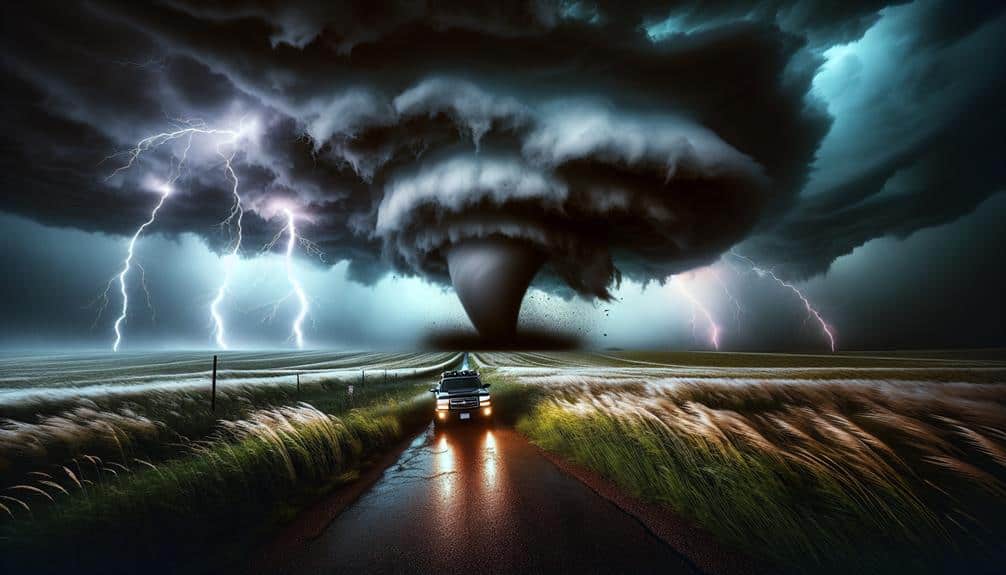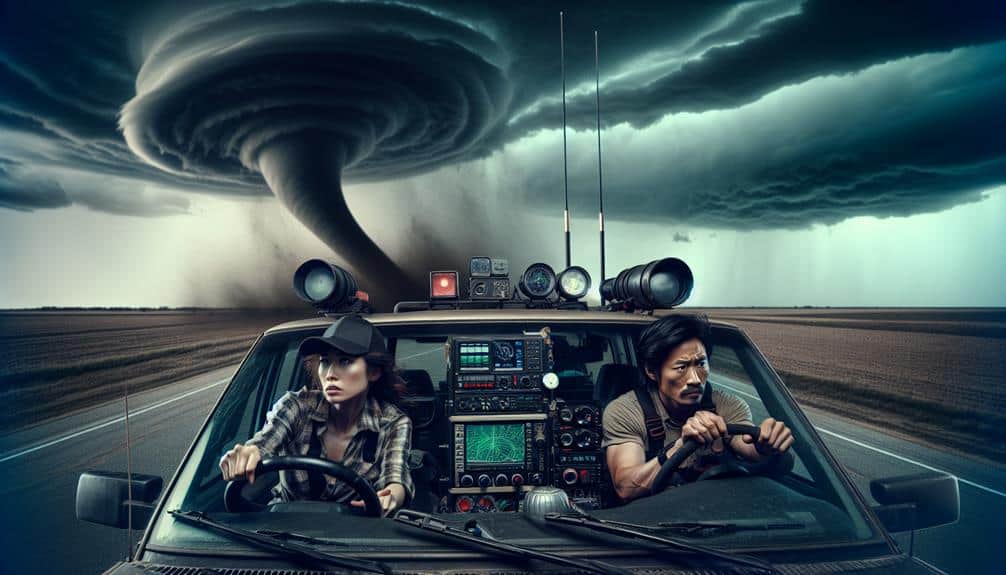We've analyzed data and identified the top storm chasing locations with precision. Tornado Alley in the USA is a prime spot, renowned for its high tornado frequency and cutting-edge storm-chasing gear. The Great Plains, including Texas and Oklahoma, offer critical opportunities from April to June. Dixie Alley presents nocturnal tornadoes and complex terrain challenges. Florida's hurricane season provides a unique experience with advanced meteorological tools. In Central Europe, severe weather peaks from May to August in areas like the Carpathian Basin. Northern Australia and the Bay of Bengal in Bangladesh and India offer unparalleled cyclone chasing scenarios. Discover the specifics and intricacies of each hotspot to maximize your storm chasing ventures.
Key Points
- Tornado Alley, USA, is famous for its high frequency of tornadoes and sophisticated storm-chasing techniques.
- The Great Plains, USA, within Tornado Alley, are hotspots like Texas and Oklahoma, ideal from April to June.
- Dixie Alley, USA, offers unique challenges with nocturnal tornadoes and complex terrain requiring meticulous planning.
- Central Europe, especially the Carpathian Basin and Po Valley, sees peak storm activity from May to August.
Tornado Alley, USA
Tornado Alley, USA, is renowned for its high frequency of tornado occurrences, making it a prime destination for storm chasers equipped with advanced meteorological tools. We employ sophisticated storm chasing techniques and gear to navigate this volatile region safely.
High-resolution radar, GPS systems, and mobile mesonets are essential for real-time data collection and analysis. Our vehicles are often outfitted with anemometers, barometers, and reinforced exteriors to withstand severe weather conditions.
Forecasting plays a critical role in our storm chasing endeavors. We analyze atmospheric data, such as wind shear, humidity, and temperature gradients, to identify potential tornado genesis areas. By chasing storm patterns, we can anticipate the development and trajectory of supercells, increasing our chances of intercepting a tornado.
Effective storm chasing requires a deep understanding of meteorological principles and quick decision-making skills. We rely on satellite imagery and Doppler radar to track storm cells, adjusting our routes based on live updates.
Safety is paramount; we maintain constant communication with fellow chasers and meteorological centers to adapt to changing conditions swiftly. Our mission isn't only to capture the awe-inspiring power of tornadoes but also to contribute valuable data to the scientific community.
Great Plains, USA
Let's focus on the Great Plains, a critical area within Tornado Alley known for frequent severe weather events.
We should analyze the prime chase seasons, typically from April to June, and identify key hotspots such as Texas and Oklahoma.
This data helps us optimize our storm-chasing strategies and safety protocols.
Tornado Alley Hotspots
The Great Plains region, particularly recognized as Tornado Alley, offers some of the most dynamic and frequent tornado activity, making it a prime location for storm chasers. Our approach prioritizes storm chasing safety, emphasizing meticulous planning and real-time data analysis. We utilize advanced meteorological tools to track supercells and tornado genesis, paying close attention to radar signatures and atmospheric instability indices.
When we head out, we're equipped with high-resolution cameras and specialized storm photography equipment. We use DSLRs with wide-angle lenses and tripods to capture the immense scale of these weather phenomena. Drones provide aerial perspectives, enhancing our data collection and visual documentation. However, the unpredictability of tornadoes requires strict safety precautions. We always verify our vehicles are in top condition, prepared for quick maneuvers.
The hotspots within Tornado Alley include locations like Oklahoma, Kansas, and Nebraska, where the confluence of warm, moist air from the Gulf of Mexico and cool, dry air from the Rockies creates perfect storm conditions. By rigorously following safety protocols and employing cutting-edge storm photography techniques, we maximize our chances of capturing these awe-inspiring natural events while staying safe.
Prime Chase Seasons
During late spring and early summer, the atmospheric conditions in the Great Plains become most conducive to severe weather outbreaks, making this period the prime chase season for storm chasers.
The dynamic interplay between warm, essential air from the Gulf of Mexico and cool, dry air from Canada creates a volatile environment ideal for supercell thunderstorms and tornado formation.
We rely on advanced storm chasing techniques and equipment to navigate these conditions safely and effectively. High-resolution radar, GPS navigation, and mobile weather stations are crucial tools in our arsenal, allowing us to track storms with precision and adjust our strategies in real time.
By analyzing data on wind shear, atmospheric instability, and dew points, we can predict the most likely locations for severe weather outbreaks.
Storm chasing photography and videos are crucial in documenting these events. High-definition cameras and drones enable us to capture stunning visuals of supercells, tornadoes, and lightning strikes.
These visuals not only provide scientific value but also inspire a sense of awe and respect for nature's power.
Dixie Alley, USA
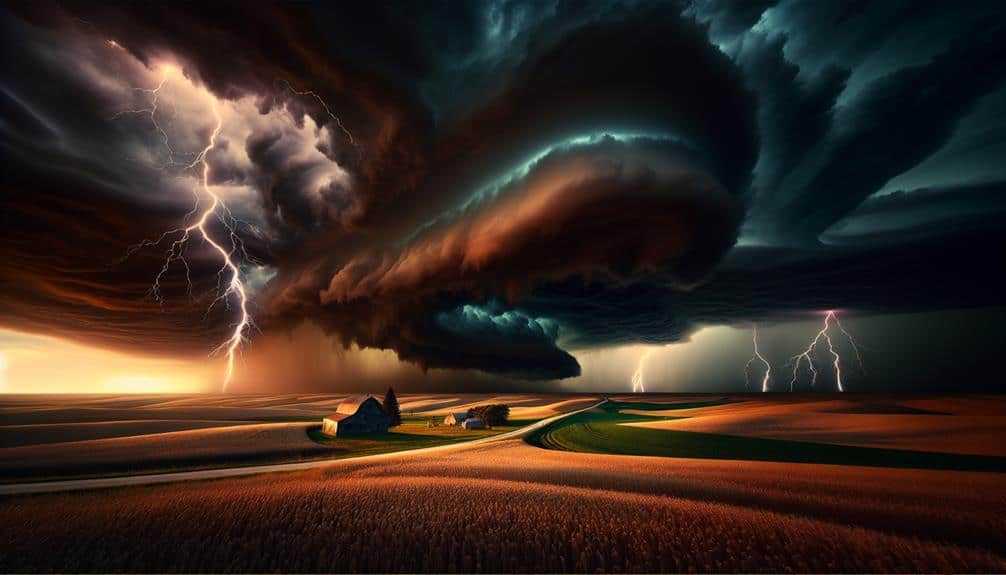
Dixie Alley, stretching across the southeastern United States, presents a unique storm-chasing environment due to its high frequency of nocturnal tornadoes and complex terrain. This region, encompassing parts of Mississippi, Alabama, Tennessee, and Louisiana, is notorious for its extreme weather events.
Unlike the Great Plains, Dixie Alley's storms often occur after dark, making them more challenging to track and increasing the risk factor for chasers. Effective risk management is essential here. The dense tree cover and hilly landscapes limit visibility, requiring us to rely heavily on advanced meteorological tools and real-time data.
Mobile radar units, GPS, and communication devices are indispensable for safely navigating this complex environment. The high population density also means we must be vigilant about public safety, ensuring our activities don't interfere with emergency responses.
Historical data indicates that Dixie Alley experiences a higher fatality rate from tornadoes compared to other regions. This underscores the need for meticulous planning and real-time adjustments based on evolving weather patterns. By integrating cutting-edge technology with on-ground observations, we can mitigate risks and enhance our storm-chasing experiences in this volatile yet alluring region.
Florida, USA
Florida offers a unique storm chasing experience with its frequent tropical storms and hurricanes, requiring specialized strategies to safely navigate and document these powerful weather phenomena. When it comes to hurricane chasing in Florida, it's crucial to have a thorough understanding of storm tracks, wind patterns, and evacuation routes. We rely on advanced meteorological tools such as Doppler radar, satellite imagery, and GPS systems to monitor storm progression in real-time.
Lightning photography on Florida beaches presents another thrilling challenge. The state's coastline, especially during the summer months, witnesses a high frequency of lightning strikes due to the convergence of sea breezes and afternoon thunderstorms. Our equipment includes high-speed cameras, tripods, and remote triggers to capture the electrifying moments securely from a distance. We often position ourselves along the Gulf Coast or the Atlantic shores, where the unobstructed horizon enhances the dramatic effect of lightning against the darkened sky.
In both hurricane chasing and lightning photography, Florida requires careful planning and a profound respect for the raw power of nature. By utilizing precise data and implementing robust safety measures, we guarantee that we not only capture stunning visuals but also maintain the highest standards of safety and preparedness.
Central Europe
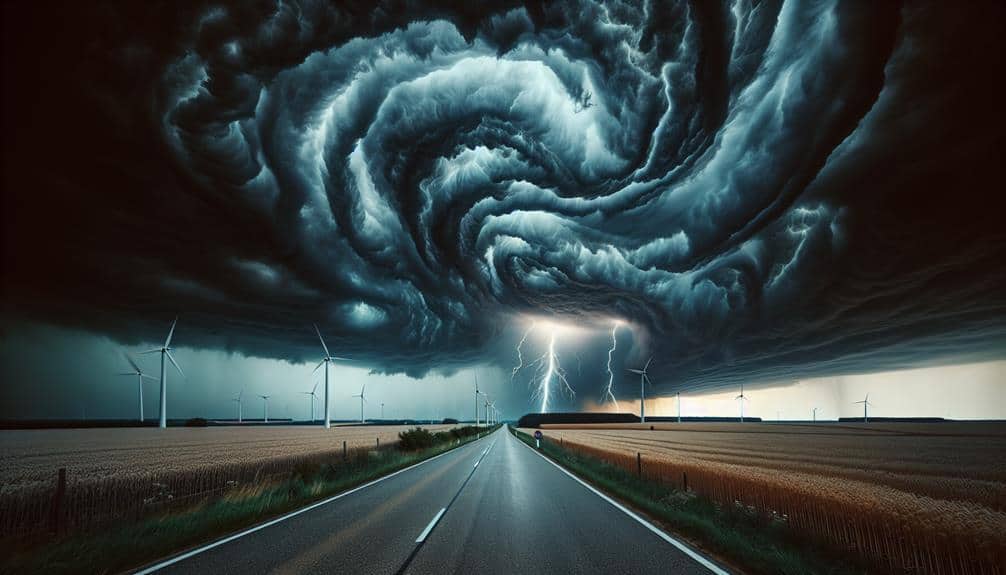
In Central Europe, we observe peak storm activity from May to August, providing prime conditions for storm chasing.
Key locations such as the Carpathian Basin and the Po Valley offer frequent severe weather events.
Adhering to local safety regulations is essential, as each country enforces specific guidelines for storm chasers.
Prime Storm Seasons
Central Europe offers prime storm chasing opportunities from late spring through early autumn, with peak activity often occurring between May and August. During this period, atmospheric conditions are ideal for severe weather, including thunderstorms and tornadoes.
To maximize our storm chasing experience, we need to take storm chasing safety into account and use the best equipment available.
Storm chasing in Central Europe demands precise planning and readiness. Here are key points to ensure a successful and safe chase:
- Timing: Late afternoon and early evening are typically the best times to observe storm development. Meteorological data shows that convective storms often peak during this period.
- Location: Targeting areas with a history of severe weather can increase our chances of witnessing a significant event. Regions like the German plains and Austrian valleys are known hotspots.
- Safety Gear: Having a reliable radar app, GPS, and a weather radio is essential. We should also carry first aid kits and emergency supplies.
- Vehicle: A sturdy vehicle equipped with a dashcam and communication tools guarantees we stay informed and connected.
Popular Storm Chasing Spots
Focusing on the most popular storm chasing spots in Central Europe, we should prioritize regions like the German plains and Austrian valleys, where severe weather events frequently occur. These areas are known for their dynamic weather patterns, making them prime locations for witnessing thunderstorms, supercells, and occasionally, tornadoes.
To maximize our storm chasing experience, it's essential to understand the storm chasing risks and implement safety precautions meticulously.
Equipping ourselves with the right storm chasing equipment is crucial. High-resolution radar, GPS navigation, and reliable communication devices should be at the top of our list. Additionally, always having a first aid kit, water supplies, and extra fuel can make a significant difference in emergency situations.
Preparation tips include studying weather forecasts extensively and familiarizing ourselves with local road networks to ensure we can navigate effectively during a chase.
In Central Europe, the flat terrain of the German plains allows for better visibility and easier navigation, reducing the risk of getting caught in dangerous weather. Similarly, the Austrian valleys offer unique vantage points but require extra caution due to their complex topography.
Safety and Regulations
Before embarking on a storm chasing expedition in Central Europe, we must adhere to strict safety guidelines and understand the local regulations governing such activities. This region's weather patterns can be unpredictable, necessitating thorough storm preparation and emergency response planning.
First, let's focus on weather forecasting. Accurate weather prediction is crucial for identifying potential storm chasing opportunities. We should rely on reputable meteorological agencies and advanced radar systems to track storm developments.
Next, we need to establish safety precautions to safeguard our wellbeing during these excursions. Here are four essential steps to follow:
- Emergency Kit: Always have an emergency kit containing first aid supplies, water, food, and essential tools.
- Communication Devices: Equip ourselves with reliable communication devices, such as satellite phones or two-way radios, to stay connected in remote areas.
- Vehicle Maintenance: Ensure our vehicle is in top condition, with full fuel tanks and spare tires, as breakdowns in severe weather can be hazardous.
- Local Regulations: Familiarize ourselves with local laws and regulations regarding storm chasing. Some areas may have restrictions or require permits.
Northern Australia
Northern Australia consistently offers prime storm chasing opportunities due to its unique climatic conditions and seasonal monsoon patterns. During the cyclone season, which spans from November to April, the region experiences numerous tropical cyclones. These storms provide us with a thrilling spectacle of nature's raw power. Adequate preparation is essential as we gear up to document and study these events. Ensuring that all equipment is ready and safety measures are in place allows us to capture the data we need while minimizing risk.
The extreme weather in Northern Australia has a significant impact on both the environment and local communities. With wind speeds exceeding 150 km/h and torrential rainfall, these cyclones can cause extensive flooding and structural damage. This makes it an ideal location for those of us who seek to understand the dynamics of severe weather systems. By analyzing the patterns and effects of these storms, we contribute valuable insights into improving forecasting models and emergency response strategies.
The combination of intense meteorological phenomena and the opportunity to contribute to scientific knowledge makes Northern Australia a prime destination for storm chasers who crave both adventure and purpose.
Bangladesh and India
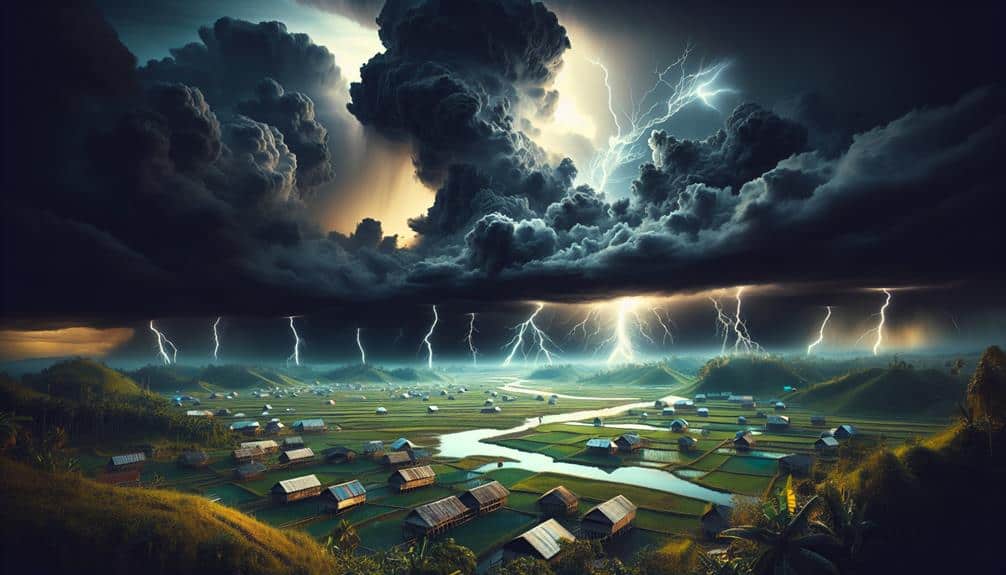
Bangladesh and India offer unparalleled storm chasing experiences due to their frequent and powerful cyclones driven by the Bay of Bengal's unique meteorological conditions. These regions provide a thrilling blend of extreme weather and rich cultural impact, perfect for storm chasers looking for both scientific insight and breathtaking photography opportunities.
During the monsoon season, the Bay of Bengal becomes a hotspot for cyclones, making it an ideal time for storm chasing. Here, we can expect:
- Intense Cyclonic Activity: The unique geography of the Bay of Bengal fosters powerful cyclones, often reaching Category 4 or 5.
- Diverse Meteorological Data: The region's weather patterns offer valuable data for storm prediction models and climate research.
- Rich Cultural Context: Experiencing how local communities prepare for and respond to extreme weather can provide profound insights into the cultural impact of these natural phenomena.
- Stunning Photography Opportunities: The dramatic skies and turbulent seas during a cyclone offer unparalleled chances to capture nature's raw power.
Frequently Asked Questions
What Equipment Is Essential for Storm Chasing?
Let's investigate the truth: storm chasing requires rigorous safety precautions. Our essential gear includes a reliable vehicle, weather radar, GPS, first aid kit, and communication devices. This equipment guarantees we stay safe and informed during our pursuit.
How Do You Stay Safe While Storm Chasing?
We prioritize safety precautions by having a detailed emergency plan. Constant communication and real-time weather updates are critical. We use precise data to navigate storms and guarantee we're always aware of changing conditions to stay safe.
What Time of Year Is Best for Storm Chasing?
Although some might think summer is too late, we find the peak season for tornadoes is actually spring. The best locations are in Tornado Alley, where data shows the highest frequency of severe weather events.
Are There Any Storm Chasing Tours Available?
Yes, there are several storm chasing tour options available. These tours focus on popular destinations like Tornado Alley and the Great Plains. They provide expert guidance, ensuring safety and maximizing our chances of experiencing severe weather phenomena.
How Do Weather Forecasts Aid in Storm Chasing?
Weather forecasts are crucial to our storm chasing strategies. They help us analyze weather patterns and predict storm paths. Accurate forecasting allows us to optimize our routes and maximize safety while experiencing the thrill of storm chasing.

